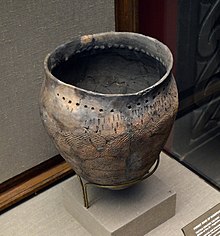| Alternative names | Textile Ceramic culture |
|---|---|
| Geographical range | Finland, northwestern Russia |
| Period | Bronze Age |
| Dates | 1900 BCE – 500 BCE |
| Preceded by | Volosovo culture, Fatyanovo–Balanovo culture |
The Netted Ware culture (also called Textile Ceramic culture) was a Bronze Age culture in northeastern Europe that extended from Finland to the upper Volga region in Russia.
Origins

The Netted Ware culture emerged around 1900 BCE with the arrival of the Seima-Turbino phenomenon in the upper Volga region, replacing the earlier Fatyanovo–Balanovo and Volosovo cultures, and soon expanded to the west to Karelia and eastern and central Finland. The Netted Ware culture did not reach southwestern Finland, the area of the Kiukainen culture and later the Nordic Bronze culture. The subsistence of the Netted Ware culture was based on small-scale swidden agriculture and animal husbandry.
Hypothetical linguistic affiliation
The spread of the Netted Ware culture has been linked to the dispersal of early forms of the Finno-Volgaic languages, especially Finnic languages and Saami languages.
References
- ^ Carpelan, Christian; Parpola, Asko (2001). "Emergence, contacts and dispersal of Proto-Indo-European, Proto-Uralic and Proto-Aryan in archaeological perspective". In Christian Carpelan; Asko Parpola; Petteri Koskikalli (eds.). Early contacts between Uralic and Indo-European: Linguistic and archaeological considerations (PDF). Mémoires de la Société Finno-Ougrienne 242. Helsinki: Société Finno Ougrienne. pp. 55–150. Retrieved 7 Dec 2022.
- ^ Parpola, Asko (2017). "Finnish vatsa – Sanskrit vatsá – and the formation of Indo-Iranian and Uralic languages". Journal de la Société Finno-Ougrienne. 2017 (96). doi:10.33340/susa.70229. hdl:10138/311944.
- ^ Nichols, Johanna (2021). "The Origin and Dispersal of Uralic: Distributional Typological View". Annual Review of Linguistics. 7 (1): 351–369. doi:10.1146/annurev-linguistics-011619-030405.
This article relating to archaeology is a stub. You can help Misplaced Pages by expanding it. |